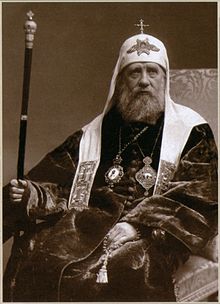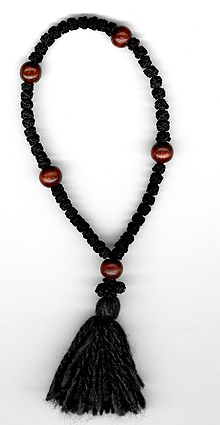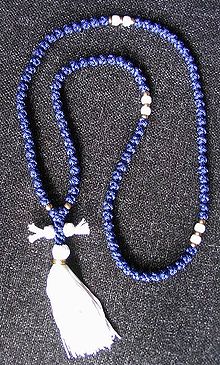- Prayer rope
-
A prayer rope (Greek: κομποσκοίνι, Russian: чётки, Romanian: mătănii, Macedonian and Serbian: бројаница / brojanica, Bulgarian: броеница) is a loop made up of complex knots, usually out of wool or silk.
The prayer rope is part of the habit of Eastern Orthodox monks and nuns[1] and is employed by monastics (and sometimes by others) to count the number of times one has prayed the Jesus Prayer or, occasionally, other prayers.
Contents
Description
Historically, the prayer rope would typically have 100 knots, although prayer ropes with 50 or 33 knots can also be found in use today. There are even small, 10-knot prayer ropes intended to be worn on the finger. Hermits in their cells may have prayer ropes with as many as 300 or 500 knots in them.
There is typically a knotted cross where the prayer rope is joined together to form a loop, and a few beads at certain intervals between the knots (usually every 10 or 25 knots) for ease in counting. Longer prayer ropes frequently have a tassel at the end of the cross; its purpose is to dry the tears shed due to heartfelt compunction for one's sins.[2] The tassel can also be said to represent the glory of the Heavenly Kingdom, which one can only enter through the Cross.
The prayer rope is commonly made out of wool, symbolizing the flock of Christ[3]; though in modern times other materials are used also. The traditional color of the rope is black (symbolizing mourning for one's sins[4]), with either black or colored beads. The beads (if they are colored) and at least a portion of the tassel are traditionally red, symbolizing the blood of Christ and the blood of the martyrs. In recent times, however, prayer ropes have been made in a wide variety of colors.
Though prayer ropes are often tied by monastics, lay persons are permitted to tie them also. In proper practice, the person tying a prayer rope should be of true faith and pious life and should be praying the Jesus Prayer the whole time.
According to Orthodox Serbs, the 33 knotted prayer rope should be worn on the left hand, and when praying, held with the thumb and forefinger of the right hand. The 33 knots symbolize the age of Jesus Christ when he died.[5]
Use
 St. Tikhon of Moscow in his monastic habit with a white prayer rope in his left hand
St. Tikhon of Moscow in his monastic habit with a white prayer rope in his left hand
When praying, the prayer rope is normally held in the left hand, leaving the right hand free to make the Sign of the Cross. When not in use, the prayer rope is traditionally wrapped around the left wrist so that it continues to remind one to pray without ceasing. If this is impractical, it may be placed in the (left) pocket, but should not be hung around the neck or suspended from the belt. The reason for this is humility: one should not be ostentatious or conspicuous in displaying the prayer rope for others to see.
During their Tonsure (religious profession), Eastern Orthodox Monks and Nuns are given a prayer rope, with the words:
Accept, O brother (sister) (name), the sword of the Spirit which is the word of God (Ephesians 6:17) in the everlasting Jesus prayer by which you should have the name of the Lord in your soul, your thoughts, and your heart, saying always: "Lord Jesus Christ, Son of God, have mercy on me a sinner."
The prayer rope is considered to be the sword of the Spirit, because prayer which is heartfelt and inspired by the grace of the Holy Spirit is a weapon that defeats the Devil.
Among some Orthodox monastics (and occasionally other faithful), the canonical hours and preparation for Holy Communion may be replaced by praying the Jesus Prayer a specified number of times dependent on the service being replaced. In this way prayers can still be said even if the service books are for some reason unavailable or the person is not literate or otherwise unable to recite the service; the use of a prayer rope is a very practical tool in such cases, simply for keeping count of the prayers said. However, among some monastics, e.g., hesychastss, this replacement is the norm.
One scheme for replacing the Divine Services with the Jesus Prayer is as follows[6]:
- Instead of the entire Psalter: 6000 Jesus Prayers
- One kathisma of the Psalter: 300 prayers (100 for each stasis)
- Midnight Office: 600
- Matins: 1500
- The Hours without the Inter-Hours: 1000;
- The Hours with the Inter-Hours: 1500
- Vespers: 600
- Great Compline: 700
- Small Compline: 400
- A Canon or Akathist to the Most Holy Theotokos (Mother of God): 500
Over the centuries, various cell rules have developed to help the individual in the daily use of the prayer rope. However, there is no single, standardized method that is used universally throughout the Church. There may be prostrations after each prayer or after a certain number of prayers, depending upon the particular rule being followed.
Not only is the Jesus Prayer used, but Eastern Christians also have many "Breath Prayers". Contrary to thought, they are not to be said using spiritual breathing as that can only be determined by a spiritual father. Some breath prayers that are continuously repeated on the Prayer Rope are: Lord Have Mercy, Come Lord Jesus, Lord I Believe...Help My Unbelief, Lord Save Me, etc.
History
Leather Lestovka with cloth "leaves".
The history of the prayer rope goes back to the origins of Christian monasticism itself. When monks began going into the deserts of Egypt, it was their custom to pray the entire 150 Psalms every day. However, because some of the monks were unable to read, they would either have to memorize the psalms or perform other prayers and prostrations in their stead. Thus the tradition of saying 150 (or more) Jesus Prayers every day began.
The western Rosary is sometimes said to have the same initial origin.
The invention of the prayer rope is attributed to Saint Pachomius in the fourth century as an aid for illiterate monks to accomplish a consistent number of prayers and prostrations in their cells. Previously, monks would count their prayers by casting pebbles into a bowl, but this was cumbersome, and could not be easily carried about when outside the cell. The use of the rope made it possible to pray the Jesus Prayer unceasingly, whether inside the cell or out, in accordance with Saint Paul's injunction to "Pray without ceasing" (I Thessalonians 5:17).
It is said that the method of tying the prayer rope had its origins from the Father of Orthodox Monasticism, Saint Anthony the Great. He started by tying a leather rope with a simple knot for every time he prayed Kyrie Eleison ("Lord have Mercy"), but the Devil would come and untie the knots to throw off his count. He then devised a way--inspired by a vision he had of the Theotokos--of tying the knots so that the knots themselves would constantly make the sign of the cross. This is why prayer ropes today are still tied using knots that each contain seven little crosses being tied over and over. The Devil could not untie it because the Devil is vanquished by the Sign of the Cross.
Notes
- ^ Robinson, N.F. (1916). Monasticism in the Orthodox Churches. Milwaukee, WI: Young churchman Company. ISBN 0-404-05375-0. http://books.google.com/books?id=raQPAQAAIAAJ&printsec=frontcover&dq=Monasticism+in+the+Orthodox+Church+by+N.+F.+Robinson&source=bl&ots=fqvPB1Py2s&sig=JpOI61DapDmf_dzxTH2OT4sdq5s&hl=en&ei=jg6lTK3iBJPtngf_x-WQAQ&sa=X&oi=book_result&ct=result&resnum=5&ved=0CBsQ6AEwBA#v=onepage&q&f=false.
- ^ cf. Comboschini (The Prayer Rope) Meditations of a Monk of the Holy Mountain Athos
- ^ cf. Comboschini (The Prayer Rope) Meditations of a Monk of the Holy Mountain Athos
- ^ cf. Comboschini (The Prayer Rope) Meditations of a Monk of the Holy Mountain Athos
- ^ Lepavina Monastery, Duhovni razgovor o.Gavrila sa bratom Mladenom (in Serbian)
- ^ cf. Orthodox Tradition The Prayer Rope, The Prayer Rope Piccola guida alla preghiera con la corda di preghiera
See also
External links
Categories:- Eastern Orthodoxy
- Eastern Catholicism
- Christian prayer
- Hesychasm
- Meditation
- Prayer beads
- Christian monks
- Instead of the entire Psalter: 6000 Jesus Prayers
Wikimedia Foundation. 2010.




